The Intel Optane SSD 900p 480GB Review: Diving Deeper Into 3D XPoint
by Billy Tallis on December 15, 2017 12:15 PM ESTAnandTech Storage Bench - Heavy
Our Heavy storage benchmark is proportionally more write-heavy than The Destroyer, but much shorter overall. The total writes in the Heavy test aren't enough to fill the drive, so performance never drops down to steady state. This test is far more representative of a power user's day to day usage, and is heavily influenced by the drive's peak performance. The Heavy workload test details can be found here. This test is run twice, once on a freshly erased drive and once after filling the drive with sequential writes.
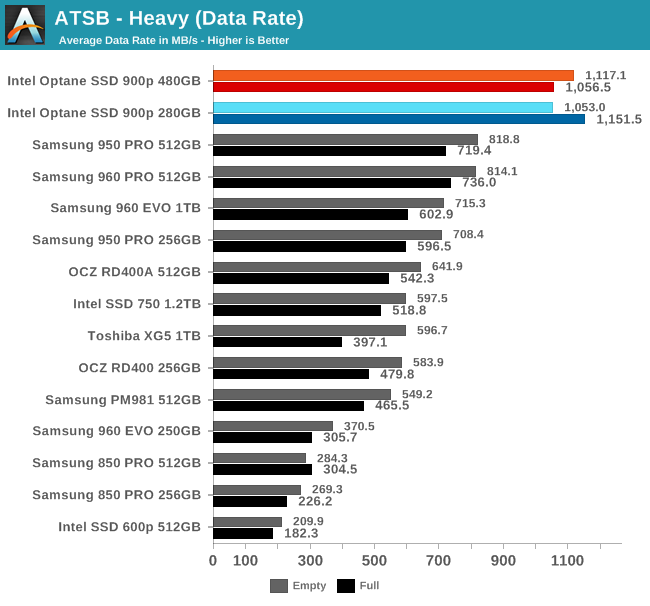
The Optane SSD 900p in either capacity delivers a much higher average data rate on the Heavy test than any flash-based SSD. As with the original review, the 280GB model is a bit faster when the drive is pre-filled than when the test is run on a freshly-erased drive; the opposite is almost always true of flash-based SSDs. The 480GB's results look more normal and fall in the same range as the 280GB's scores.

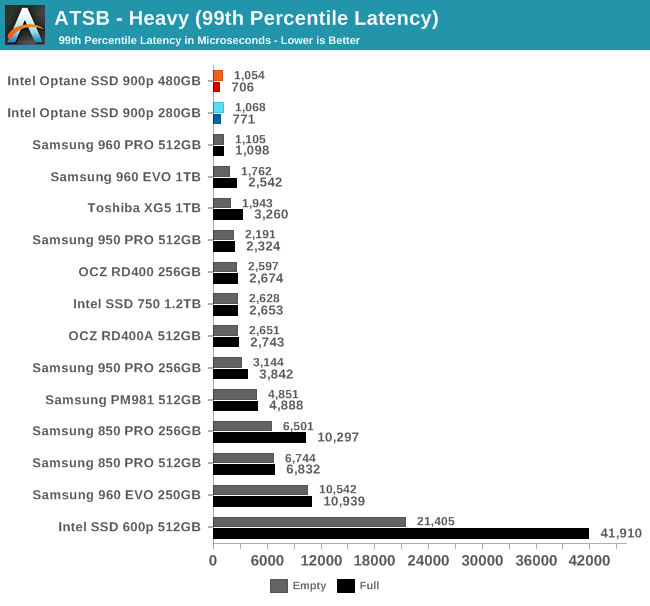
The average and 99th percentile latency scores of both Optane SSD capacities are slightly ahead of the fastest flash-based SSDs. Both models also show lower latency when the drive is filled than when it is freshly erased.

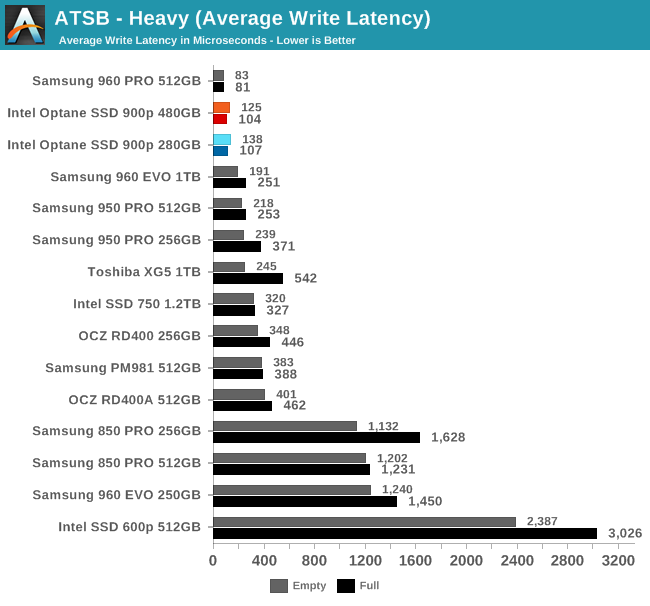
The average read latency of the Optane SSD 900p on the Heavy test is about the same for both capacities, and about half that of any flash-based SSD. The average write latencies are a bit worse than the Samsung 960 PRO but still clearly better than the 960 EVO or anything else.
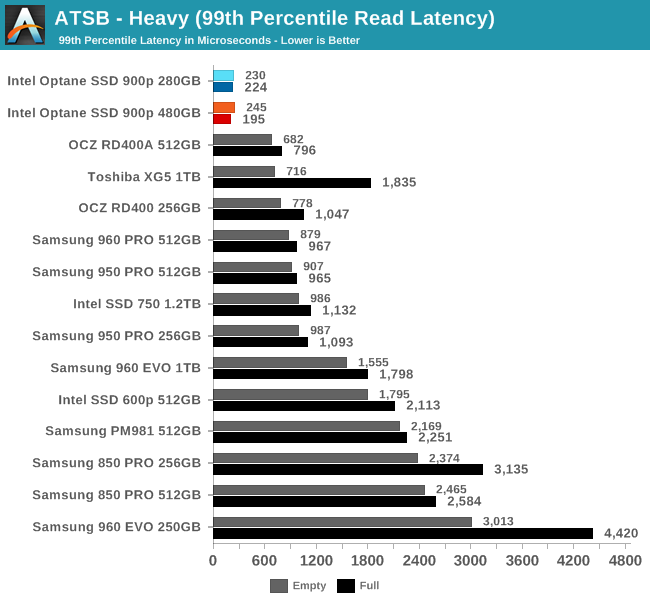
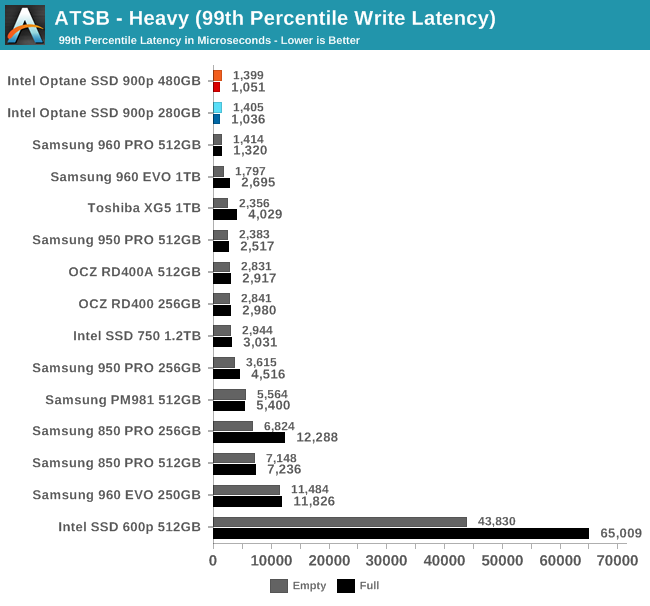
The 99th percentile read latency scores for the Optane SSDs are a fraction of the latency of any other drive, and both capacities of the 900p score about the same. The 99th percentile write latency is barely faster than the Samsung 960 PRO.
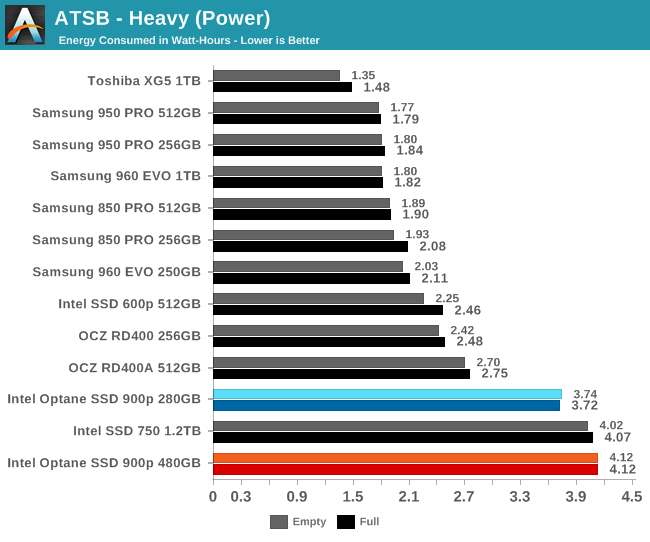
The power consumption of the Optane SSDs fits their heritage as derivatives of an enterprise drive. The only other consumer SSD this power hungry is the Intel SSD 750, another enterprise derivative. Even the M.2 PCIe SSDs with relatively poor power management and low performance use much less energy over the course of the test.
The 480GB 900p uses about 10% more energy than the 280GB model while performing about the same.










69 Comments
View All Comments
nathanddrews - Friday, December 15, 2017 - link
Is there any indication that performance would degrade with a lesser CPU or improve with a faster CPU? Just curious if we should expect CPU bottlenecks from these hyper-speed SSDs.Billy Tallis - Friday, December 15, 2017 - link
Yes, CPU speed can definitely affect latency and consistency and maximum achievable IOPS. Some of those limits were hit with the P4800X testing on a server with lower per-core performance than this consumer testbed.At the moment, my inclination is to leave the consumer test suite single-threaded, because consumer workloads don't actually hit the queue depths necessary to go beyond the I/O capabilities of a single CPU core. I don't care too much if the high QD range on some of the graphs doesn't quite reach the theoretical limit of the drive, because that's not the part of the graph we should be paying attention to. (For consumer drives.)
At low queue depths, interrupt servicing latency can be helped a bit by a faster CPU. But for most consumers, switching from Windows to Linux will do a lot more to help reduce their storage latency. And saving a few more microseconds only matters on Optane; mainstream products won't be this fast for quite a while.
ddrіver - Friday, December 15, 2017 - link
I think I'll have to reevaluate my position on Optane. Seems like a solid product. Guess I misread the signs.ddriver - Friday, December 15, 2017 - link
How can you tell a fake "ddriver" apart? Well, the real one would never mislabel the product hypetane ;)It is what it is, and still nowhere nearly "1000x" better as intel claimed. It has its niche strengths, but those offer no tangible benefit to 99.9999% of the consumers out there. I don't recall ever claiming that it will suck, my claim has always been that it will epically fail to live up to the hype, which testing thoroughly confirms. It is not even 10% of "1000x better". So hypetane it is.
SLC flash can easily match and even bet it in most performance metrics. Unfortunately the industry is not even trying, even mlc is now considered "ultra high end enterprise". Which is understandable, as the workloads that could actually benefit from higher performance are very few and far in between, and for 99% of them using ram is the more applicable and still tremendously better performing solution.
It is definitely not a bad product on its own. And I would not refer to it as "hypetane" if only intel hadn't shamelessly lied about it on such a preposterous scale.
tuxRoller - Friday, December 15, 2017 - link
Interface speeds≠ media speedsWhen will you learn?
Also, still need a reference for those SLC numbers.
LordanSS - Saturday, December 16, 2017 - link
Indeed, Interface speeds are not "media" speeds. I never expected it to work according to Intel's "1000x" claims, but was hoping for a more in-line 20x better from what we currently have, considering first generation product and all.And it doesn't even do that. Sorry, for this one time, I am (partially) siding with ddriver.
lmcd - Saturday, December 16, 2017 - link
20X better overall is entirely unrealistic. Certain attributes are 20X better. That is all you can really expect when so many things (form factor, power usage, interface protocols, physical interface, etc) are retained from the previous generation.LordanSS - Sunday, December 17, 2017 - link
20x is 2% (TWO PERCENT) of what Intel claimed when they disclosed XPoint. It's not realistic?Intel shoul have kept their mouth shut back then, just like Micron has done so until now. If they can't even do 2% of what they claimed, they're the unrealistic ones.
tuxRoller - Sunday, December 17, 2017 - link
Were those claims that Intel made in reference to xpoint the tech, or optane the first gen product?tuxRoller - Saturday, December 16, 2017 - link
I'm not sure why you are quoting media, but you are absolutely welcome to be disappointed.You'll notice I don't care whether anyone thinks Intel over hyped their product only that we still don't know what the actual xpoint (the media, or "tread + xfer + Misc" times, as Handy refers to it) response times look like.
If AT doesn't allow the below link, search for "xpoint presence in slow lane explained" on the register, or Google "Why XPoint SSDs won't meet original speed claims: A guide"
https://www.theregister.co.uk/2016/09/29/xpoint_pr...